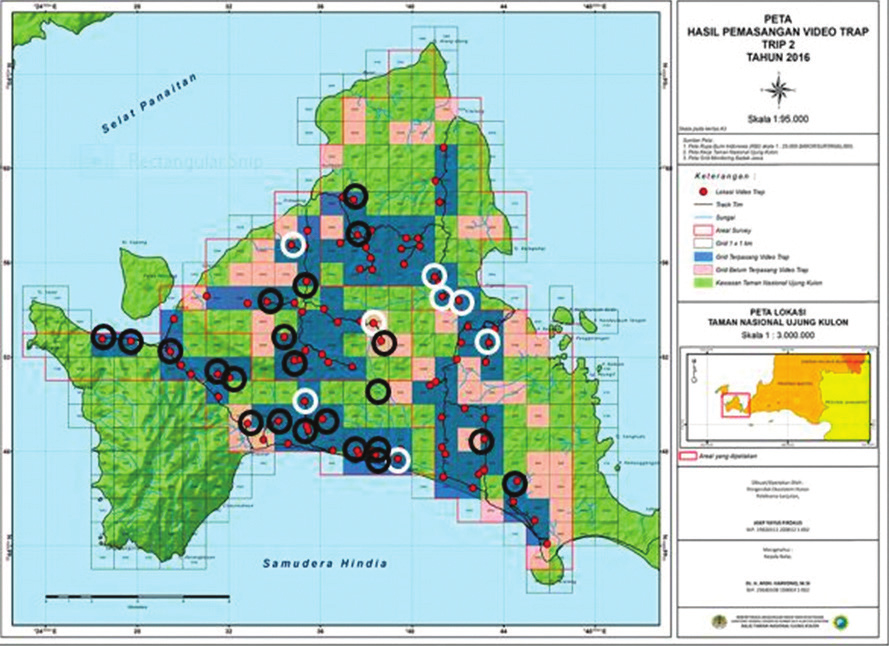More than just mud: the importance of wallows to Javan rhino ecology and behaviour
DOI:
https://doi.org/10.69649/pachyderm.v61i.10Abstract
All members of the family Rhinocerotidae have the need to wallow in mud or water to protect their skin from sun damage, remove ectoparasites and for thermoregulation purposes. Just 72 wild Javan rhino (Rhinoceros sondaicus) remain on the planet, all located in their last stronghold in Ujung Kulon National Park (UKNP), West Java, Indonesia. Javan rhinos need to wallow regularly throughout the year, yet the role wallows play in their behaviour and the importance to the species remains little understood. In this study, we identified, mapped and studied 35 wallows in eastern UKNP, where rhinos were active. We spatially mapped and recorded each wallow’s characteristics. We examined rhino wallowing behaviour using 392 remote camera trap videos, taken across UKNP during a five-year study from 2011 to 2016. We identified and categorised eight behavioural patterns at and near wallows related to rhino daily activities and found that wallows have several key features for the Javan rhinos. Findings revealed that Javan rhinos, who construct the wallows themselves, choose sites with 75% shade cover and often at an elevation. Analysis of the rhino calls from camera trap videos taken at and near wallows, identify seven vocalisation descriptors with accompanying sonograms, a first for this rare and shy rainforest species. We discovered that Javan rhino utilise wallows not only for thermoregulatory function, but also as sites of interaction and communication. This has important implications for conservation and potential translocation of rhinos, which will require finding sites with suitability for the construction of wallows.
Tous les membres de la famille des rhinocérotidés ont besoin de se vautrer dans la boue ou l'eau pour protéger leur peau des dommages du soleil, éliminer les ectoparasites et à des fins de thermorégulation. Il ne reste que 72 rhinocéros de Java (Rhinoceros sondaicus) sauvages sur la planète, tous situés dans leur dernier bastion du parc national d'Ujung Kulon (UKNP), à West Java, en Indonésie. Les rhinocéros de Java doivent se vautrer régulièrement tout au long de l'année, cependant le rôle des mares boueuses dans leur comportement et leur importance pour l'espèce restent peu compris. Dans cette étude, nous avons identifié, cartographié et étudié 35 mares boueuses dans l'est de l’UKNP, où les rhinocéros étaient actifs. Nous avons cartographié spatialement et enregistré les caractéristiques de chaque mare. Nous avons examiné le comportement des rhinocéros se vautrant dans la boue en utilisant 392 vidéos de pièges photographiques à déclenchement à distance, vidéos prises sur l’ensemble de l'UKNP au cours d'une étude de cinq ans de 2011 à 2016. Nous avons identifié et catégorisé huit modèles de comportements à proximité de et aux mares boueuses liées aux activités quotidiennes des rhinocéros et nous avons constaté que les mares boueuses ont plusieurs caractéristiques clés pour les rhinocéros de Java. Les résultats ont révélé que les rhinocéros de Java, qui construisent eux-mêmes les mares, choisissent des sites à 75% d'ombre et souvent en altitude. L’analyse des appels vocaux enregistrés dans les vidéos prises à l’aide de pièges photographiques à proximité de et aux mares boueuses, identifie sept descripteurs de vocalisation accompagnés de leurs sonogrammes, une première pour cette espèce rare et timide habitant en forêt tropicale. Nous avons découvert que le rhinocéros de Java utilise les mares non seulement pour leur fonction thermorégulatrice, mais aussi comme sites d'interaction et de communication. Cela a des implications importantes pour la conservation et le transfert potentiel des rhinocéros, et nécessitera de trouver des sites convenant à la construction de mares boueuses.

Downloads
Published
Versions
- 2020-11-11 (2)
- 2020-10-08 (1)



